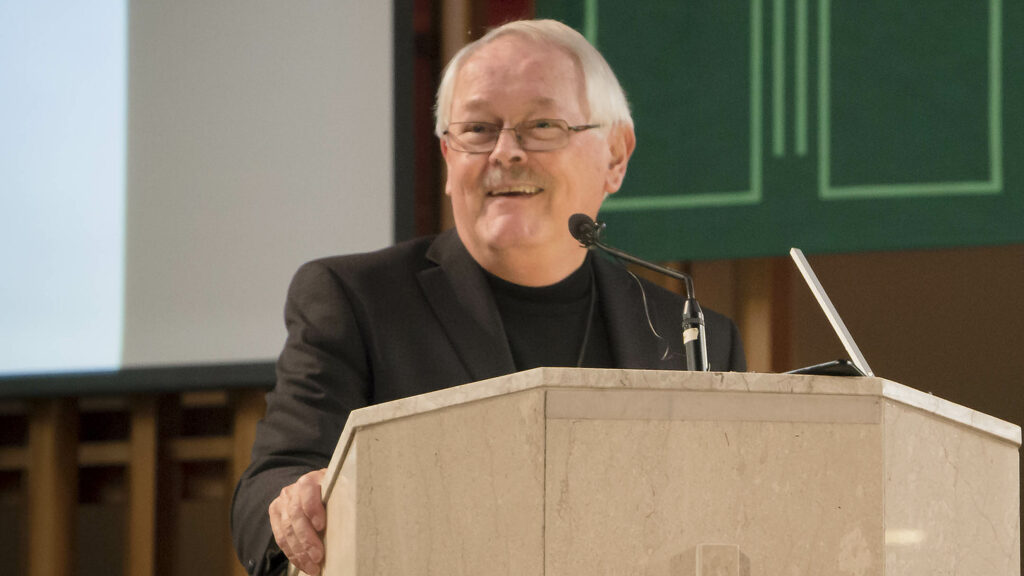In a recent book, Living Between Worlds, James Hollis offers a piece of wit that carries more depth than is first evident. A therapist says to a client, I cannot solve your problem, but I can give you a more compelling story for your misery. That’s more than a wisecrack. Whether we feel good or bad about ourselves is often predicated on what kind of story we understand ourselves as living within.
I remember a seminar some years ago where one of the keynote speakers was a young French Canadian priest, Pierre Olivier Tremblay. Tremblay began his talk with words to this effect: I am a chaplain at a university, working with young college students. They are full of life, dreams, and energy; sadly, however they are mostly devoid of hope because they have no meta-narrative. They suffer a lot because they do not have a bigger story within which to understand themselves and make more sense of their own story. Their own stories, precious though they are, are too small and individualistic to give them much to draw on when pain and heartache beset them. They need a bigger story within which to situate themselves, a meta-narrative. While this wouldn’t necessarily take away their pain and heartaches, it would give them something bigger within which to understand their suffering.
Hearing this, I think of my parents and the spirituality that helped sustain them and their generation. They had a meta-narrative, namely, the Christian story of salvation history and of how, in that story, at the very beginning of history, Adam and Eve committed an ‘original sin’ that has ever since skewed reality so as to leave us with the impossibility of ever attaining the full symphony in this life. When their lives got hard, as is the case with all of us, they had a religious perspective as to why they were frustrated and in pain. They understood themselves to be born into a flawed world and a flawed nature. Hence, their prayer included the words, for now we live, mourning and weeping in a valley of tears.
Today we might frown on this and see it as unhealthy and morbid, but that narrative of Adam and Eve helped give some explanation and meaning to all the shortcomings in their lives. While it didn’t take away their pain, it helped give dignity to their miseries. Today I see many sincere parents trying in new ways to give a bigger narrative to their young children through stories like The Lion King. That might indeed be helpful for young children; but as Pierre Olivier Tremblay points out, eventually a much bigger and more compelling narrative is needed.
The story within which we frame our pain makes all the difference in the world vis-a-vis how we cope with that pain. For example, James Hillman tells us that perhaps the biggest pain we experience with aging is our idea of aging. This is true too for many of our struggles. They need the dignity of being seen under a larger canopy. I like what Robertson Davies says when he laments that he doesn’t want to struggle with a ‘growing edge’, but wants rather to be ‘tempted by demon’. He wants to accord a higher dignity to his temptations!
A bigger story brings us this dignity because it helps us differentiate meaning from happiness. We invariably confuse the two. What we need to seek in life is meaning, not happiness. Indeed, happiness (as we generally understand it) can never be pursued because it is always a byproduct of something else. Moreover, happiness is ephemeral and episodic; it comes and goes. Meaning is abiding and can co-exist with pain and suffering. I doubt that Jesus was particularly happy as he hung dying on the cross, but I suspect that inside of all the pain, he was experiencing deep meaning, perhaps the deepest meaning of all. Not incidentally, he found this deepest of all meaning because he understood himself as being inside the deepest of all stories.
At the end of the day, faith, religion, community, friendship, and therapy, cannot take away our problems. Most times, there isn’t any solution; a problem must be lived through. As Gabriel Marcel famously put it, life is a mystery to be lived, not a problem to be solved. The story within which we frame our pain is the key to turning problem into mystery.
Art Schopenhauer once wrote that all pain can be borne if it can be shared. The sharing he was referring to doesn’t just have to do with friendship, community, and intimacy. It also has to do with story. Pain can be to borne more generatively when it finds itself inside a larger story than our own, when it shares a meta-narrative, a horizon wide enough to dwarf idiosyncratic loneliness.
Hollis is right. No therapist can solve our problem, but he or she can help us find a bigger story that can give more meaning and dignity to our misery.

